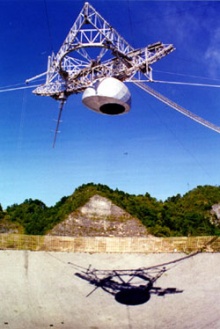SETI@home 的故事
The Story of SETI@home SETI@home 的故事
In surveying the skies in search of a signal from an alien civilization, the various SETI programs have been very successful in collecting massive amounts of radio data. But collecting radio signals from space is not enough: one must still sift through the billions of channels surveyed, and differentiate between man-made interference, naturally occurring signals, and "The Real Thing". This requires massive amounts of time on the world's largest and fastest computers. Sadly, these kinds of resources are rarely available to SETI researchers, and processing the signals has become a bottleneck in the search.
In 1994, David Gedye and Craig Kasnoff, two computer scientists from Seattle, came up with a brilliant solution to this problem: instead of running a single large computer for a long time, why not run thousands of small computers for short periods of time? This could be done, they reasoned, by having people from around the world download a simple data-processing program on their personal computers. The program would not interfere with the regular operation of the computer and would only run during its idle time. Once a batch of data was processed, the computer would return it and receive a new batch to process in its place.
It took five more years and a founding contribution by The Planetary Society to turn this idea into a reality, but in May 1999, SETI@home went online. Its success was immediate and overwhelming. Whereas the founders envisioned tens of thousands of users, or several hundred thousand at the most, SETI@home's popularity skyrocketed and quickly reached into the millions. Today, more than five million users have downloaded the program onto their personal computers! This makes SETI@home easily the world's largest supercomputer.
SETI@home is currently transitioning from its traditional “stand alone” format to being part of the BOINC family of distributed computing projects. BOINC, which stands for Berkeley Online Infrastructure for Network Computing, was developed by SETI@home Project Director David Anderson to build on SETI@home’s remarkable success. In essence, BOINC is a computing platform that makes it easy for any interested group of scientists to launch a distributed computing project. Although the venture is new, numerous scientific projects have already taken advantage of the enormous potential of BOINC. What began as a search for intelligent beings in the universe, now enables computer users around the world to take part in research on topics from gravitational waves to climate change.
